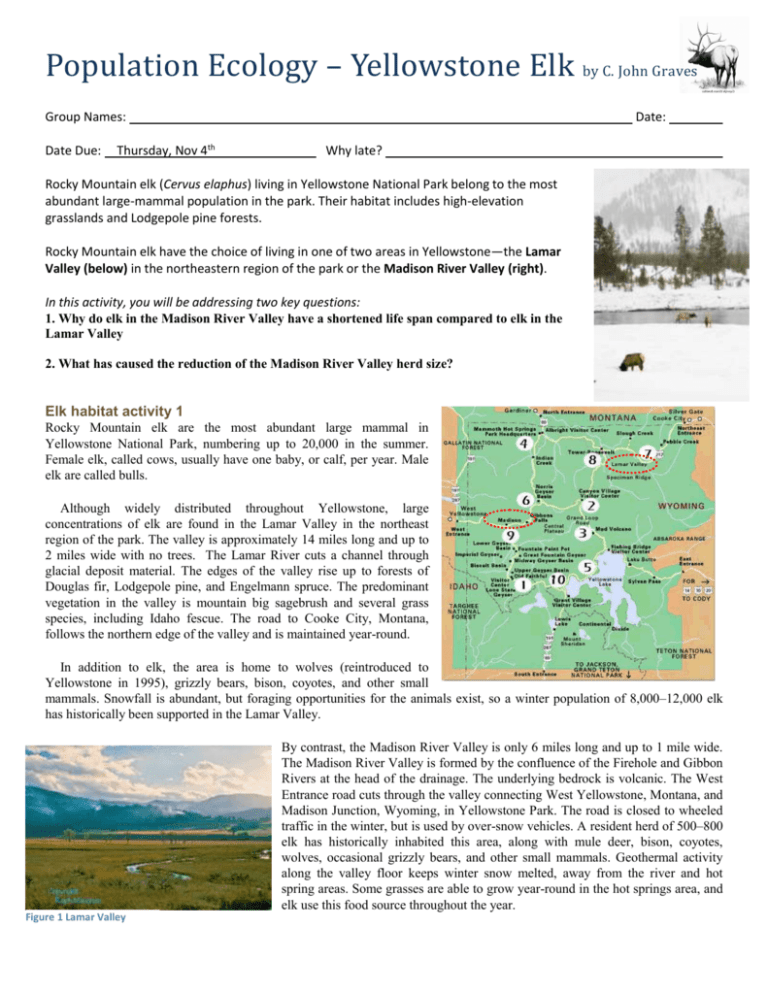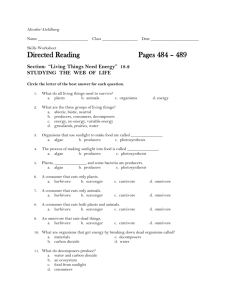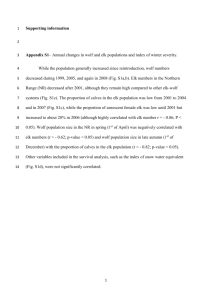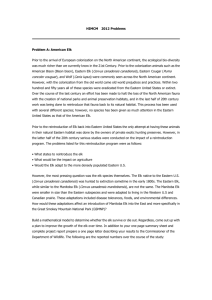Population Ecology – Yellowstone Elk by C. John Graves Group
advertisement

Population Ecology – Yellowstone Elk by C. John Graves Group Names: Date Due: Thursday, Nov 4th Date: Why late? Rocky Mountain elk (Cervus elaphus) living in Yellowstone National Park belong to the most abundant large-mammal population in the park. Their habitat includes high-elevation grasslands and Lodgepole pine forests. Rocky Mountain elk have the choice of living in one of two areas in Yellowstone—the Lamar Valley (below) in the northeastern region of the park or the Madison River Valley (right). In this activity, you will be addressing two key questions: 1. Why do elk in the Madison River Valley have a shortened life span compared to elk in the Lamar Valley 2. What has caused the reduction of the Madison River Valley herd size? Elk habitat activity 1 Rocky Mountain elk are the most abundant large mammal in Yellowstone National Park, numbering up to 20,000 in the summer. Female elk, called cows, usually have one baby, or calf, per year. Male elk are called bulls. Although widely distributed throughout Yellowstone, large concentrations of elk are found in the Lamar Valley in the northeast region of the park. The valley is approximately 14 miles long and up to 2 miles wide with no trees. The Lamar River cuts a channel through glacial deposit material. The edges of the valley rise up to forests of Douglas fir, Lodgepole pine, and Engelmann spruce. The predominant vegetation in the valley is mountain big sagebrush and several grass species, including Idaho fescue. The road to Cooke City, Montana, follows the northern edge of the valley and is maintained year-round. In addition to elk, the area is home to wolves (reintroduced to Yellowstone in 1995), grizzly bears, bison, coyotes, and other small mammals. Snowfall is abundant, but foraging opportunities for the animals exist, so a winter population of 8,000–12,000 elk has historically been supported in the Lamar Valley. Figure 1 Lamar Valley By contrast, the Madison River Valley is only 6 miles long and up to 1 mile wide. The Madison River Valley is formed by the confluence of the Firehole and Gibbon Rivers at the head of the drainage. The underlying bedrock is volcanic. The West Entrance road cuts through the valley connecting West Yellowstone, Montana, and Madison Junction, Wyoming, in Yellowstone Park. The road is closed to wheeled traffic in the winter, but is used by over-snow vehicles. A resident herd of 500–800 elk has historically inhabited this area, along with mule deer, bison, coyotes, wolves, occasional grizzly bears, and other small mammals. Geothermal activity along the valley floor keeps winter snow melted, away from the river and hot spring areas. Some grasses are able to grow year-round in the hot springs area, and elk use this food source throughout the year. 1 If you were an elk, in which habitat would you choose to live and why? 2 What major differences do you notice between the two habitats? 3 What effect do you think predation has on the elk herds in the two habitats? Elk habitat activity 2 In the mid 1990s, researchers began to notice changes in the population numbers of the two elk herds. The average age of Lamar Valley elk was approximately 16 years, with the oldest animals living 20–25 years. In the Madison River Valley, however, the average age of elk was approximately 10 years, with no elk living beyond 16 years. 1 What are your initial reactions to the age difference in the two habitats? List and explain as many causes as you can. 2 What investigations would you conduct to determine the cause of the difference in life span between elk in their two habitats? Elk habitat activity 3 In mid-January 1995, 14 wolves were reintroduced to Yellowstone National Park in an attempt to re-establish the predator in a historical ecosystem after its removal in the early 1900s. Pro-reintroduction advocates argued that the absence of wolves had created an artificial predator–prey food chain and that reintroduction would return the ecosystem to a more realistic historical balance. These wolves were captured in Canada and placed in three 1-acre holding pens. One of these pens was located near the Lamar Valley. The wolves were released into the wild a few months later, and began to establish territories and prey on large mammals, especially elk, which make up 90% of the wolves’ winter diet. In winter, a wolf pack will kill up to 14 elk per month. In January 2008, 443 wolves lived in 51 packs in the Greater Yellowstone ecosystem. Out of the 51 packs, 11 packs (171 wolves total) lived within the borders of Yellowstone National Park. 1. What impact did reintroducing the wolves have on elk in Yellowstone National Park? 2. Is this information adequate to explain the life span difference in the Lamar Valley and Madison River Valley elk? Explain: 3. What additional information is needed to adequately explain the difference in life span? Elk habitat activity 4 In the mid-1990s, researchers discovered stark differences between the jaws of Lamar Valley elk and the jaws of Madison River Valley elk (see image below). Lamar Valley elk jaws showed typical wear of teeth at the time of death (Figure 1A). Madison River Valley elk jaws, however, showed accelerated and malformed wear patterns of teeth and abnormalities in jaw development (Figure 1B). Because of these abnormalities, many Madison River Valley elk died of starvation. By 2004–2005, researchers also began to observe a decrease in the population of the Madison River Valley elk herd size. The historical numbers of up to 800 elk living in the valley were now reduced to 150–200. 1. What new evidence is give above and how does it factor into the difference in average age of the two elk habitats? 2. What do you believe could be the cause of accelerated and malformed wear of teeth and jaws in Madison River Valley elk herds? 3. What possible explanations are there for the reduced population size? List & describe all that come to mind. Elk habitat activity 5 Researchers discovered that as the heavy snows of the Madison River Valley accumulated over the season, elk tended to congregate in the river valley, especially around areas of hot spring activity, to forage on the plants that grow year-round in the geothermal areas. Plants gathered from these areas contained high concentrations of fluorine (F) and silicon dioxide (SiO ). 2 Silicon dioxide is created when silicon-rich volcanic rock dissolves and comes in contact with geothermal water. As the geothermal water comes to the surface and cools, the dissolved silicon dioxide falls out of the solution, forming deposits. Silicon dioxide is found in streams and can be deposited on trees, boardwalks, and so on. It is also found in the water absorbed by the roots of plants that live in the hot spring areas. It is hard, like rock, and very abrasive. When ingested by elk, fluorine concentrates in mineral tissues such as teeth and bone. The jaws of elk living in the Madison River Valley contained more than six times the levels of fluorine found in the jaws of elk from the Lamar Valley. These levels of fluorine become toxic to the developing teeth and jaws of young elk, resulting in uneven or excessively rapid teeth wear and jaw formation. Of the 74 jaws researchers collected in the Madison River Valley, 78% showed the classic signs of fluoride poisoning. 1 What new evidence is described above and how does it factor in to the difference in average age of the two elk habitats? 2 Does this new information cause you to reject any early hypotheses? Explain. 3 Does this new information adequately explain the decrease in herd population? Explain. 4 Are there any new hypotheses to explain the decrease in herd size? Create 2-3 new possible explanations. Elk habitat activity 6 Wolves primarily prey on the young and weak members of a population. Because the average age of the Madison River Valley elk herd has been reduced due to the toxic levels of fluorine and the ingestion of silicon dioxide, higher numbers of adult elk are susceptible to predation by wolves due to the reduced number of younger elk. In addition, the snow pack on the slopes adjacent to the Madison River Valley is deep. Wolves have learned to force the elk away from the geothermal areas in the river drainage and into the surrounding slopes where the elk get stuck in the deep snow and become easy prey. 1 What additional evidence is given above? How does it further explain the reduced population in the Madison River Valley elk herd? 2 As a group, discuss the complexities involved in explaining the differences between the elk in the Lamar Valley and the elk in the Madison River Valley. 3 Explain how habitat plays a role in the differences between the population of the two elk herds. Using 3 examples from this reading, show how the elk populations were affected by different aspects of each habitat. 1 2 3







